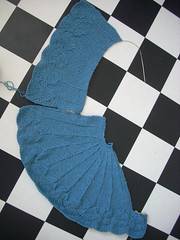For this project I have learnt how to graft garter stitch. I have grafted stocking stitch before ("Kitchener stitch") and was happily surprised garter stitch was easier. Excellent instructions here. (Of course, this is a form of sewing too, but I don't mind it that much when the resulting seam looks like knitting.)
I have been asked how I modified the decreases knitting the border.
Here are the four kinds I've used:
 1. "knit two together" for decrease to slant to the right.
1. "knit two together" for decrease to slant to the right.2. "slip one as if to knit, slip one more as if to knit, put both back on left needle and knit them together through back loops" for decrease to slant to the left.
3. "slip one as if to knit, slip one more as if to knit,knit one, pass slipped stitches over the stitch just knitted" for a double decrease when the middle stitch is top of a purl ladder (to avoid a purl on top). You could simply knit three together (the knit stitch to the left would end up on top instead of the one to the right) but that decrease feels slightly more like a bump in my picky fingers' opinion.
4. "slip two together as if to knit, knit one, pass slipped stitches over the stitch just knitted" for a double decrease where the middle stitch end up on top of the other two.


















